#chinese woodwind instruments music
Explore tagged Tumblr posts
Text
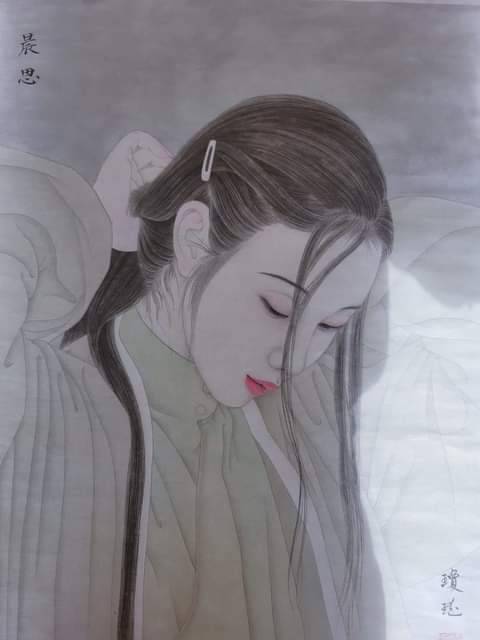



"晨思"
by Joyce Cheng (觀法如幻) /法名:覺幻
我愛這雨後天,這平原的青草一片!我的心沒底止的跟著風吹,風吹:吹遠了香草,落葉,吹遠了一縷雲,像煙——像煙。
─ 林徽因 (1904-1955, Chinese architect & poet)/中國���史上第一位女建築學者。北京人民英雄紀念碑和中華人民共和國國徽深化方案的設計者。她是建築學家梁思成的第一任妻子。
youtube
木音入肝 Wooden music heal the liver 《閑庭絮》In The Courtyard
Chinese Woodwind instruments Music, represented by ancient instruments such as the xiao flute, hulusi, and bamboo flute, exudes a graceful, melodious, and profound quality. Its sounds soar high without being overpowering, and sink low without losing their essence, weaving together in an unbroken melody that mirrors the rejuvenation of withered wood in the spring, filled with the vitality of new life. This music enters the liver and gallbladder meridians, capable of soothing liver qi stagnation, promoting smooth flow of qi, balancing blood pressure, and purifying blood quality. Listening to wooden music during nighttime rest can aid in peaceful slumber. For those who are suspicious, timid, or experiencing emotional unrest, it also possesses exceptional therapeutic qualities. Regular exposure to wooden tones can transform one's temperament, invigorate the spirit, calm the mind and body, alleviate insomnia, and facilitate the harmonious integration of body and mind, guiding individuals back to their original peaceful human nature.
木系音樂是,古簫、葫蘆絲、竹笛等演類的音樂舒展、悠揚、深遠,使人飄速欲仙高而不亢,低而不雕,編綿不斷,好似枯木連春,春意盎然。入肝膽之經,可以疏肝解鬱,舒心暢氣,平和血壓清血質,夜間休息時聽有助往安睡,對於疑心膽小、精神不安的人,也有很好的理療效果,多聽木音,可以轉移性情,增弦精神,安定身心,消除失眼,讓身心合一重新找到原始平和的人性。
19 notes
·
View notes
Text
why Divine Beast Dancing Lion has the best soundtrack in the entire game
When I watched the first DLC trailer 6 months ago, I was so focused on Messmer that I never gave the lion dancers a second thought. But in a shocking turn of events, Divine Beast Dancing Lion is now my favorite boss in the whole game. To me, what makes this fight truly exceptional is its soundtrack, so I want to go through the music and outline all the things that make it so great!
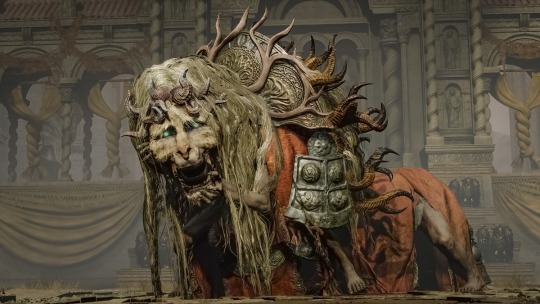
What makes the music stand out is that it feels SO different from the rest of the OST… the majority of the boss tracks have a pretty similar style and instrumentation, but Divine Beast stands out in my opinion because of how it emphasizes its rhythm and texture.
Conceptually, this boss fight is first and foremost a dance — you are fighting two Hornsent warriors operating a lion costume based on the traditional Chinese lion dance in an arena that’s actually a giant stage.
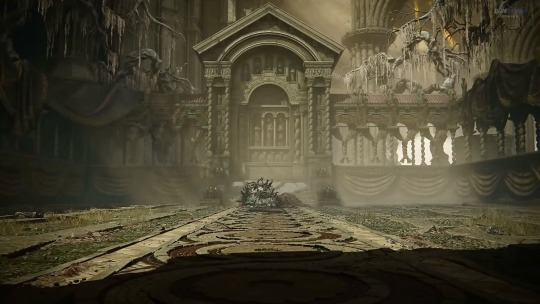
The Chinese lion dance is typically accompanied only by percussion (drums, gongs, and cymbals). So naturally, Divine Beast’s soundtrack has much more pronounced percussion in comparison to the rest of the soundtrack, featuring heavy drum beats and cymbals, plus shouts and chants from the choir. The music is in a steady 6/8, with 2 beats per measure divided into three pulses (think 1 2 3, 1 2 3) giving it a lilting, dancelike quality (this type of meter is often used in folk and traditional dances!). And, in the boss’s second phase, the dancing lion’s lightning, wind, and frost phases each have their own music and are timed to transition as the music transitions. The whole boss fight is programmed like a dance, so when you fight the boss it feels like you’re dancing with it too!
The choir has a range of vocalizations that goes beyond singing melodies and harmonies; as I touched on before, they’re also shouting and chanting. The shouts are used percussively and help accent the rhythm of the dance, and the low chanting also brings to mind a sort of religious ritual? Which is exactly what this boss fight is… in Hornsent culture, the lion dance is a ritual for invoking divinity:
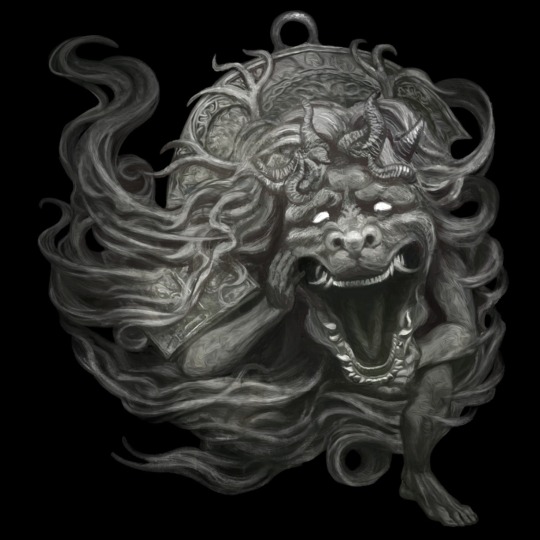
“A charm depicting the crazed, cavorting dance of the divine beast conducted at the tower festival. Raises potency of storms. Divine beasts are messengers of the heavens, and their rage mirrors the tumult of the skies, of which storms are the pinnacle.” (Enraged Divine Beast talisman)
The lion dancers, or “sculpted keepers,” are those amongst the divine beast warriors (themselves the chosen amongst the tower’s horned warriors) who truly excelled at divine invocation, and were “granted the honor of the lion dance” (Divine Beast Warrior Armor). In the boss cutscene, the Hornsent Grandam calls upon the divine beast to possess the bodies of the sculpted keepers, and rise again to defend the tower… so the lion dance, performed by warriors skilled in divine invocation, is essentially a ritual for invoking the presence of the divine beast within the dancers in order to commune with the heavens.
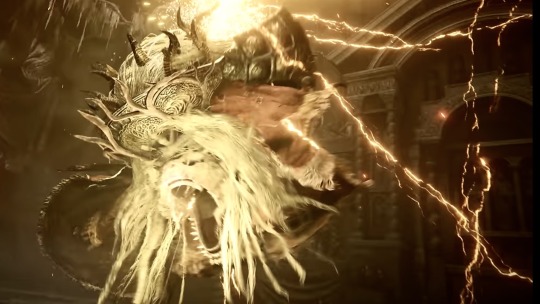
The sculpted keepers, having invoked the rage of the divine beast, are able to channel the forces of the stormy skies — lightning, wind, and frost. The force of the storm is represented in the music by quick runs in the high woodwinds and strings that come and go like gusts of wind. The music almost never lets up or loses momentum; it goes at a powerful, furious pace until the end, embodying the divine beast’s fury.
But the Divine Beast that we fight has an extra layer of emotion that goes beyond divine ritual:
“When the Impaler's army assailed the tower, the ritual of the lion dance was turned toward martial ends—its divinity, its fury, its light-footed beauty.” (Remembrance of the Dancing Lion)
What was once a beautiful ritual dance conducted at the tower festival was forced to become a weapon of war in order to fight against their people’s annihilation at the hands of Messmer’s crusade. And even this was not enough…
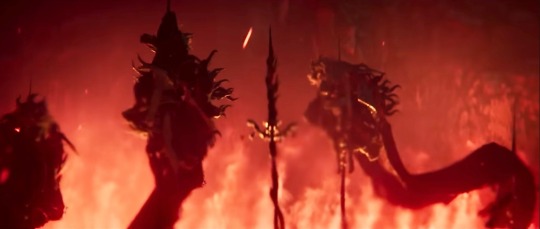

The Dancing Lion that we fight was slain, lying in a pool of dried blood, when it is miraculously awoken again with a fervent prayer. This is the last lion dance that may ever take place, giving us a mere glimpse of this ruined city’s long-vanished splendor.
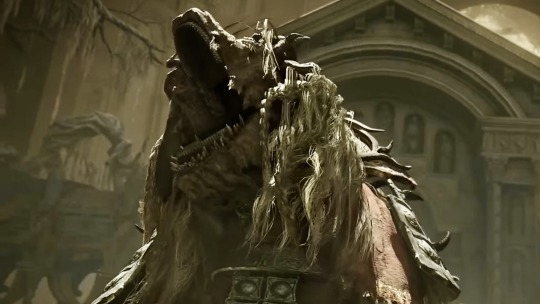
Listening to the soundtrack, there is not only pride in the music, but also an urgent, visceral, warlike rage, a multitude of voices joining in a desperate fight for their civilization’s very survival.
#elden ring#divine beast dancing lion#shadow of the erdtree#elden ring lore#this fight is CINEMA!!!!!!!!!!!!!
591 notes
·
View notes
Text
Some ideas for Twisted Wonderland events
(*Mild spoilers for some JP server events and Chapter 6)
-A Mulan-themed event: In one of the Halloween events, Silver mentioned knowing the story of Mulan, and Lilia has mentioned having been to "the East" before (not to mention Diasomnia's Halloween costumes are longs). It would be lovely to see Lilia return to the TWST-equivalent of China with some of his friends and meeting new characters--bonus points if someone is twisted from Mushu. A story about a girl who makes a sacrifice for her aging father by enlisting in the military on his behalf fits well with Silver and Lilia, so now would be the perfect opportunity to give them duo magic! Also, Chinese xianxia/martial arts fantasy novels are very popular in Japan and abroad nowadays (if you know, you know :) ), and I would love to see the boys wearing hanfu--they'd look so majestic and cool!
-Sam's hometown event: A Princess and the Frog event where the boys go to the TWST version of New Orleans, chaperoned by Sam. It would be a great opportunity to explore the jazz and culinary scene, and, of course, wear 1920s-inspired clothing. Someone in Octavinelle gets an SSR.
-A pajama-party event: Night Raven College hosts an all-night pillow fight tournament, and everyone gets extremely competitive, kind of like Beanfest. Everyone wears pajamas--I'm not sure if they'd have their own outfits, or if the dorms would match and have PJ sets with their logo on it (kind of like the pajamas they sell at the JP Disney Store). In battle, the chibis throw pillows at each other.
-Octavinelle hometown event: We are introduced to the Tweels' parents and/or Azul's mother. Given how Jamil and Kalim's hometown event carried out, it is likely that only one of the three will actually get an event card, but we'll see. In the Halloween event, Riddle mentioned that he's never seen the sea before. Even though he's had a chance in the Lost in the Book with Stitch event (and the developers probably want to give the spotlight to different characters), I'm afraid he doesn't remember it. Anyway, he deserves to go again. Alternatively, there's an event where the boys go to the Sunshine Lands and meet Prince Rielle. In this case, Riddle and Azul must go together--it would be nice to see after the events of Chapter 6.
-Riddle and Trey hometown event/Black Butler crossover: We've already had a Heartslabyul-themed hometown event with Deuce, but this time, we get to meet Trey's family and Riddle's mother. The likelihood that we get a canon Black Butler crossover as well is very close to zero, but it would be really fun to make a few jokes/hints about Riddle having a younger cousin who wears an eyepatch and solves mysteries with his enigmatic butler. Bonus points if Riddle and Jade have duo magic and dress up in Victorian/ouji clothing.
-J-fashion event: Speaking of ouji clothing, it would be amazing if there was an event inspired by Japanese fashions and subcultures. I think there was a part in one of the anthology mangas where Vil gave the Pop Music Club a visual kei makeover. I know the Pop Music Club has their own SSRs already, but I wouldn't mind seeing more outfits in this style.
-An orchestra-themed event: Some of the NRC students form a classical orchestra. Malleus is there, of course--I imagine him playing the cello this time. The Octavinelle trio is there as well with their respective instruments, as is Idia and Riddle both playing violins. I can see Jamil playing a woodwind instrument--maybe a flute, a clarinet, or an oboe?
#disney twisted wonderland#twisted wonderland#twst#riddle rosehearts#trey clover#azul ashengrotto#jade leech#jamil viper#malleus draconia#lilia vanrouge#silver vanrouge#twst silver#twst sam
162 notes
·
View notes
Text
an (incomplete) list of traditional chinese instruments
I recently had the chance to attend a few lectures by members of the National Chinese Orchestra - Taiwan, and I thought I'd share some of the information they gave (this is by no means a complete list and is based mostly on the notes I took during lecture)
Chinese instruments are divided into four families of instruments: woodwind, bow string, plucked string, and percussion. They are also divided into eight categories based on the material they are made of (or, in some cases, used to be made of). These categories are stone, earth, bamboo, metal, skin, silk, wood, and gourd.
笛子 (dízi)
There are five main types of 笛子: 曲笛 (qūdí),梆笛 (bāngdí),大笛 (dàdí),小笛 (xiǎodí),and 口笛 (kǒudí)。 They are traditionally made of bamboo and vary in length, resulting in different note ranges and timbres. 曲笛 and 梆笛 are the most common. 梆笛 is higher pitched and brighter due to its shorter length, and it is often used in music from northern China. 曲笛 has a much warmer, rounder sound due to its longer length and is often used in southern music. 口笛 is the shortest of them all and is very shrill; it is often used to imitate bird calls. 笛子 are similar to Western flutes in that the musician controls the pitch through covering or uncovering the finger holes, but the way the instruments produce sound is different. Western flutes create sound through the vibration of the air in the instrument, and while this is part of how the 笛子 produces sound, it also has a membrane that vibrates to produce sound. 笛子 are included in the woodwind family and the bamboo category.


笛子 (左边),笙 (右边)
笙 (shēng)
The 笙 is the oldest reed instrument in the world. It is a woodwind instrument consisting of many vertical pipes with reeds at the base that the musician controls through various keys in order to play specific notes. It produces sound through a reed at the mouthpiece of the instrument that the musician vibrates with their breath. It is the only reed instrument in the world that can be played both by blowing out and by breathing in. This is due to a door-like cut-out in the reed. The 笙 can play 38 notes across three octaves. Not only can it play single notes, but it can also play chords made of multiple notes played at the same time. It has been used in a wide range of music from traditional accompaniment (to 唢呐 or 笛子) to modern jazz pieces to solo pieces. In the modern day, it is often used in Chinese orchestras as melody and/or accompaniment. 笙 is included in the woodwind family and the gourd category.
二胡 (èrhú)
The 二胡 is one of the most well-known traditional Chinese instruments. It has only two strings that the musician plays with an animal-hair bow. At the base of the 二胡 there is a small drum that has a snake skin membrane on one side. This membrane vibrates in addition to the strings' vibration, creating a distinct sound. The 二胡 is often used to imitate animal noises, such as a galloping horse, in addition to its musical notes. The musician holds the 二胡 upright as they play it, keeping pressure on the strings with one hand and using the bow with the other. Unlike many Western string instruments, the 二胡 does not have a finger board. This allows the musician to play a wide range of notes and utilize many different techniques. 二胡 is included in the bowed string family and the silk category.
革胡 (géhú)
This is one of the newest Chinese instruments. The 革胡 was created in the 1950s. Many Chinese orchestras were using cello as a bass instrument, and the 革胡 was created in order to fill the gap in the bass register in Chinese orchestras. Even still, it is a very rare instrument, and the NCO - Taiwan is one of the only orchestras who uses it in its ensemble. It was made as a combination of the cello and the 二胡。This was done in order to get the full bass sound of cello while being able to blend more easily with the 二胡 and other Chinese instruments. The strings on the 革胡 correspond to the same notes as they do on the cello, but the 革胡 also has a drum at its base similar to the 二胡。This drum was originally covered with a snake skin membrane like the 二胡, but since it is a significantly larger area to cover, it is now covered with a man-made polymer. The 革胡 is included in the bowed string family and, though it was created after silk strings fell out of use, it is included in the silk category.
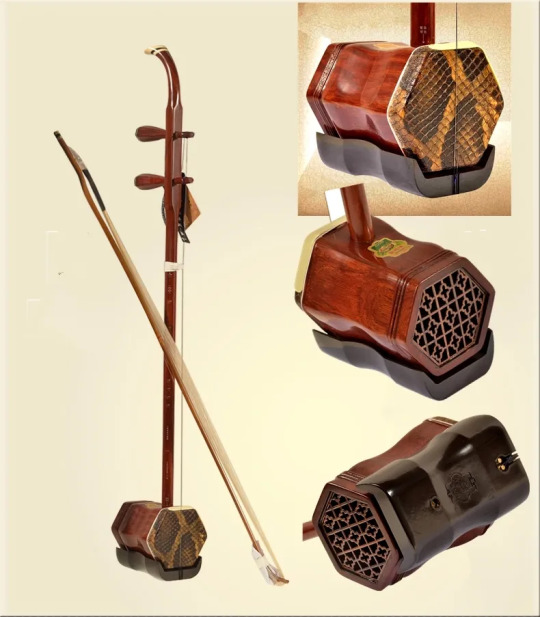

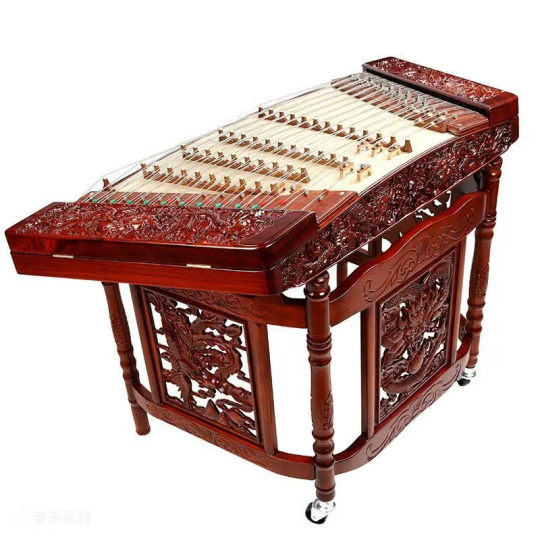
二胡 (左边),革胡 (中间),扬琴 (右边)
扬琴 (yángqín)
The 扬琴, also sometimes written 洋琴, is a percussion instrument. It was originally from Persia before it was brought to China through trade. Many countries have their own versions of this instrument, originally called the santūr, and like others' variations, the Chinese version has become unique to China. The 扬琴 has 144 strings that the musician hits with thin bamboo mallets. The strings vibrate, producing various musical notes. What is unique about the 扬琴 as compared to other variations is that it uses bamboo mallets. These are a lot more flexible than wooden mallets, and so the musician is able to play very quick notes using the vibrations of the mallet. This also allows the musician to use techniques that are unique to the 扬琴。扬琴 is included in percussion family and the silk category (the strings used to be made of silk, but they are now often made of steel).
https://web.northeastern.edu/music-chinese/
https://www.britannica.com/art/Chinese-music/Classification-of-instruments
https://www.britannica.com/art/yangqin
#i had some extra time today so thought i'd finally get to this#as always if there is something incorrect please let me know#langblr#mandarin#chinese#learn chinese#learn mandarin#chinese music#chinese culture
63 notes
·
View notes
Note
Request for a arcane/pjo/spiderverse/marvel matchup (platonic or romantic, I don’t really have a preference for it) :]
Hi! So I’m genderfluid but lean fem presenting, and use they/them pronouns. I’m aroace (romance positive/neutral, sex repulsed). My main hobbies include writing, drawing, and some martial arts (taekwondo and kickboxing specifically, but I’m trying to branch out to maybe Krav Maga or BJJ).
My interests vary, like, a lot but the stuff right now are poisonous plants and animals (jellyfish and manchineel trees specifically), the usages of mushrooms to make reusable building materials and vines as piping materials in order to create sustainable cities, BSD, f1, history in general, old-times weapons (SWORDS. So, so many swords), Sky:CotL, the 1983 revolution of Burkina Faso (real specific, sorry), and I tend to develop similar interests to people around me.
I’m an Aquarius and an INTP-T (last time I checked) with gifted kid syndrome and eldest daughter issues. I’m also Canadian and can’t stand hot climates what so ever and have social anxiety disorder and general anxiety disorder. I also play piano and most woodwind instruments and I know 2 (English, French) languages and am working on a 3rd (Italian).
Physically I’m 5,10-5,11 with pale skin and light freckles, brown-red, wavy hair that’s about a bob length in the back and has 2 longer pieces in the front as well as 2 bleached pieces. I’m plus-size and relatively muscular in my legs and shoulders (not so much in my torso and arms but eh) as well as kinda curvy. I’ve got large, slightly downturned hazel eyes and weird eyebrows but there’s nothing I can do about that. I’m looking to get some snakebites soon, as well as an industrial piercing in at least one of my ears.
My style leans between comfy stuff (jeans, hoodies, etc) and Edwardian era witch (dresses, witch hats, big leather sacs). I always wear docs and my favourite colour is green.
I don’t have a lot of preferences in other people tbh, everyone’s chill.
My favourite foods are beef barley stew, lemon meringue pie, and Ethiopian food as a whole (Chinese takeout from specifically Quality foods is the next best thing imo). I really like ovaltine and I have a few health issues that were still trying to figure out (iron deficiency + possibly pcos).
I’m not a cat or dog person, I love both don’t get me wrong, but I really like weird animals and I want a pet bear (not legal where I live or good for the animal sadly :[ )
I tend to be a bit abrasive and standoffish at first, and I can come off a bit bitchy but I swear I’m nice enough to people I care about—
———————
Idk if I did this right, sorry—
[ @scyphozoa-mancinella ]
You did it just perfect, cariño, don’t worry
——————
Your Arcane match is…
Violet

Vi would absolutely love sparring with you in taekwondo or kickboxing, and she’d probably challenge you to push your limits in Krav Maga or BJJ, giving you tips and encouragement
She’d respect your standoffishness and wouldn’t push you to open up, but she’d always be quietly watching out for you, especially if anyone messes with you
Vi would be genuinely interested in hearing about your knowledge on poisonous plants, sustainable cities, and history—she loves learning new things and would admire your vast interests
Since you’re both tough on the outside but soft towards those you care about, you’d have an unspoken understanding of each other, no need for a lot of words
Vi would get involved in your hobbies, whether it’s looking at cool swords or learning more about music and history, and she’d love that you pick up on her interests too
She’d take you to try new foods, always down to explore interesting cuisines like Ethiopian food with you
The weirder the dish, the more Vi would be into it
Vi would be into your mix of comfy and witchy clothes, and she’d probably steal your hoodies and Docs when you’re not looking
She’d love that you both have that “abrasive but secretly caring” energy and would feel comfort in knowing you don’t need constant attention but are there when it counts
Vi would push you to get stronger, especially in your martial arts, but she’d also encourage you to keep working on your creative passions like writing and drawing
She’d be there for you through your health struggles, offering quiet comfort and checking in on you without making a big deal out of it
Your PJO match is…
Thalia Beryl Grace

Credits: frostbite.studios
Thalia would immediately connect with your love of martial arts, and she’d probably challenge you to a friendly sparring match or two, admiring your skills
You and Thalia would geek out over ancient battles and old weapons, especially swords, and she’d love discussing historical revolutions with you, given her fascination with mythology and legends
Thalia would be up for exploring new places with you, especially if they involve nature or ancient ruins—she loves adventure and would appreciate your company
Thalia isn’t a touchy-feely person herself, so she’d fully understand and respect your need for personal space, never crossing any physical boundaries without your permission
Unless she were to get you out of danger’s way
She’d relate to your tough exterior and standoffishness and would respect you for standing your ground, knowing there’s a caring side underneath that not everyone gets to see
Thalia would love that you play instruments and would probably have you teach her a thing or two on the piano, especially since she’s musically inclined as well
Thalia would understand your anxiety and wouldn’t pressure you to socialize or do anything that makes you uncomfortable, always having your back in social situations
She’d enjoy your intellectual side and would be more than happy to engage in long conversations about poisonous plants, ancient battles, and anything else that piques your interest
Thalia would love your mix of comfy and witchy fashion and would probably show up in something equally cool, bonding over your shared appreciation for unique aesthetics
She’d be a quiet but solid support for you through your health struggles, never making a big deal of it but always being there when you need her
Your Spider-Man Across the Spiderverse match is…
Gwen Stacy

Gwen would love that you play piano and woodwind instruments, and she’d invite you to jam with her, teaching you some cool techniques on her drums
She’d be impressed by your martial arts skills and would probably ask you to teach her a few moves, as she’s always looking to improve her own physical abilities
Gwen would be super interested in your research on poisonous plants, sustainable cities, and historical revolutions, always listening intently and asking questions
She’d invite you on wild adventures around the multiverse, always keeping things exciting but respecting when you need a break or feel anxious
Gwen would love your unique style, especially the Edwardian witch vibes, and she’d always compliment your outfit choices, maybe borrowing your Docs for a day or two
As someone who also deals with her own issues, Gwen would completely understand your social anxiety and wouldn’t push you beyond your comfort zone, always being there to support you
She’d be mindful of your boundaries around touch and would wait for you to initiate any physical contact, whether it’s a high five or a hug
Gwen would love learning about your different hobbies and interests, especially anything related to history and weird animals—she’d even start reading up on them herself to understand you better
Gwen would be there for you through your health issues, always checking in and offering support when you need it, and she’d be a quiet but strong presence in your life
While Gwen loves adventure, she’d also know when to slow down and just hang out with you in a low-key setting, maybe watching cartoons or playing music together when life feels overwhelming
Your Marvel match is…
Shuri

Shuri would love your intellectual curiosity and dive into deep conversations about poisonous plants, sustainable building materials, and historical revolutions
She’d find your research fascinating and would love exchanging knowledge with you
Shuri would totally involve you in her lab experiments, especially when it comes to sustainable innovations like using mushrooms and vines in building materials
You’d work together on eco-friendly tech
She’d be super respectful of your need for physical space and never push you to be physically affectionate unless you’re comfortable
She’s good at reading those cues and would know exactly when to give you space
Shuri would love training with you and might even create some high-tech gadgets to enhance your martial arts, helping you with anything related to Krav Maga or BJJ
You and Shuri would constantly collaborate on creative projects, whether it’s designing new tech or discussing history and current innovations, pushing each other to think outside the box
Shuri would appreciate your interest in animals, especially the more unique ones, and she’d introduce you to the advanced wildlife tech she’s developed to help protect endangered species
Both of you have a sharp wit and a sarcastic streak, so there would be lots of playful banter between you two, but always in good fun
Shuri would invite you on amazing trips to explore new cultures, environments, and technological wonders
She’d definitely want you by her side for both adventure and learning
Shuri would appreciate your style and might even design some custom outfits for you that blend her Wakandan fashion sense with your witchy, Edwardian aesthetic
She’d be invested in helping you manage your iron deficiency and possible PCOS, possibly even creating tech to monitor and improve your health
Shuri would be deeply caring in her own unique way, always looking out for you
#request#matchups#headcanons#arcane#percy jackson#spiderman across the spiderverse#marvel#vi x reader#vi#thalia grace#thalia grace x reader#gwen stacy x reader#gwen stacy#princess shuri#shuri x reader
16 notes
·
View notes
Text
I'm a little obsessed with how the suona (嗩吶/唢呐) comes in and proceeds to kick ass in a couple of drama themes (specifically 碧苍战歌 from Legend of Shen Li and 天外來客不悲不愁金剛之身不死不休 from I Am Nobody) and pop songs, so I made a playlist of modern tracks featuring it. The playlist includes hip-hop, rock, dance, pop, and soundtrack/score pieces.
I don't know anything about woodwinds and I don't know much about traditional Chinese musical instruments, so it's possible a couple of tracks shouldn't be here. The Cui Jian song does belong here, though! That is a suona played by a saxophonist (who happens to be the son of a suona player). I've heard that iconic song a million times but hadn't realized it was a suona until I started this playlist.
If you know a song that should be on here, pass it along!
0 notes
Text
Flute Radical: 龠
On'yomi/音読み: やく(yaku)
Kun'yomi/訓読み:ふえ (fue)
17 strokes
Our first Radical and, since we're going backwards, the one with the most brush strokes. The Flute Radical represents one of the earliest Chinese woodwind instruments, with 9,000 years of history. It is believed that the flute, originally carved from bone and then later from bamboo, may have originated as a way of stoking up a fire by supplying it with oxygen before evolving into a musical instrument. The character likely a pictogram, meant to depict the pipes and with the three Mouth Radicals (口) depicting the air holes of the flute. This is more clear when we look at the earlier scripts of this character

(source:https://en.m.wiktionary.org/wiki/%E9%BE%A0)
There is some debate as to how this early flute looked, with some believing it was a single pipe with three holes, others believing it was a single pipe with six or seven holes and others believing it was multiple pipes, similar to a panflute.

Besides having the meaning of "flute" or "pipe", 龠 also refers to an outdated unit of measurement, a volume roughly equivalent to 1,200 grains of millet, pronounced as やく.
This radical does not have a lot of modern usage and so you can expect this section to be rather short. While Wiktionary lists several compounds comprised of this radical, many have simplified forms that are more commonly used, or have completely fallen out of modern use altogether. As such, I will only be posting compounds when I can find them in the dictionary without a lot of extra sleuthing. Call me lazy, haha
Sources:
0 notes
Text
my muses' favorite things...
Jayn
Food - peach ice cream & herb-crusted fish
Drink - hot coffee mixed with chocolate OR sangria
Colour - gold & where deep blue meets violet
Season - spring/summer
Scent - lavender
Instrument - violin
Time of Day - late morning
Item - anthology of fiction from her childhood
Movie - Iron Man
Naela
Food - Moroccan-style tagine (stew w/lamb, dried fruit, spices)
Drink - pretty much any fruit juice made fancy (like mimosas)
Color - periwinkle/lavender (like her/her mom's eyes)
Season - summer
Scent - fresh flowers
Music - harp OR anything by Shakira
Time of Day - late morning
Item - her sword(s) OR a worn fantasy romance paperback
Movie - The Princess Bride
Achilles
Food - banana pancakes OR spanakopita
Drink - he just wants gin, a frappuccino, an Italian soda or water
Color - sea green
Season - summer
Scent - the sea
Music - pop (like Britney Spears) & rock (like Nickelback)
Time of Day - noon
Item - a pair of earrings that his mom bought him
Movie - Star Wars III: Revenge of the Sith
Jas
Food - Japanese food (sushi, curry rice, mochi)
Drink - peppermint tea
Color - bubblegum pink
Season - spring
Scent - citrus
Music - classical (piano)
Time of Day - noon
Item - her dad’s necklace (Wayland ring on a leather cord)
Movie - A Bug’s Life (her dad took her to see it when she was little)
Skadi
Food - beef pot pie (potatoes, peas, carrots) OR blueberry muffins
Drink - something w/cinnamon (rum/horchata) OR Bai Mu Dan tea
Color - forest green
Season - spring & autumn
Scent - cinnamon OR fresh pastry
Music - low woodwinds & chanting
Time of Day - morning
Item - a Jotnar song her parent taught her
Movie - the LOTR trilogy + Good Will Hunting
Oraia
Food - dolmades (Greek stuffed grape leaves), pizettes (Italian chocolate cookies w/almonds & cinnamon)
Drink - paloma (tequila, lime juice, grapefruit soda) or mojito (white rum, sugar, lime juice, soda water & mint); peach green tea
Color - N/A, though she wears a lot of blue & white
Season - any time that isn't cold
Scent - vanilla
Music - Euopop, modern rock, anything worth dancing to
Time of Day - just after sundown
Item - the knife her mom gave her
Movie - Jumping the Broom OR Disney's Hercules
Hestia
Food - Thai coconut chicken soup OR Bûche de Noël [Yule Log]
Drink - Kahlua & Chai OR Chai Tea Latte
Color - orange
Season - winter
Scent - whatever her lover & her kid smell like
Music - 90s pop (mostly dance songs)
Time of Day - early morning
Item - picture of herself & a bunch of the X-Men outside
Movie - Love Actually
Rose
Food - garlic noodles (also she's a vegan, just sayin')
Drink - bourbon OR green tea (either w/honey)
Color - ballet pink OR white
Season - spring (no solstices & few cold breezes)
Scent - the sea
Music - punk-pop (especially acoustic covers)
Time of Day - early afternoon
Item - magic locket (allows for multidimensional comm w/father)
Movie - The Prestige
Aurelia
Food - chicken vindaloo
Drink - simple stuff. Latte. Tom Collins. CBD oil ;)
Color - jade green & gold
Season - summer
Scent - dewy grass, hot cocoa, woodsy cologne
Music - classic rock (especially The Rolling Stones)
Time of Day - early evening
Item - her wand OR a souvenir scarf from Nigeria
Movie - Die Hard OR Waiting to Exhale
Rela
Food - Jogan fruit OR a simple Chinese-style stir fry (vegetarian)
Drink - doesn’t like alcohol; Royal English Breakfast Tea (w/milk)
Color - the electric blue of a holobook
Season - autumn
Scent - trees & forests in general
Music - acoustic covers & R&B
Time of Day - middle of the night
Item - her late master, Maglos Nerot's, yellow lightsaber
Movie - historical documentaries (w/o reenactments)
Eugenia
Food - carbonara (pasta)
Drink - hates alcohol; Arnold Palmer (tea & lemonade)
Color - maroon
Season - spring
Scent - dewy grass
Music - R&B + 00s pop
Time of Day - late morning
Item - she can't pick (isn't materialistic anyway)
Movie - The Bodyguard OR Legends of the Fall
Shayera
Food - chicken mole enchiladas OR falafel
Drink - Hurricane (3x rum, grenadine, OJ, simple syrup) OR a vaguely fruity thing infused w/some caffeine
Color - hot pink
Season - autumn
Scent - cocoa butter
Music - 90s rap & modern alt (Hozier)
Time of Day - noon
Item - her mace
Movie - The Equalizer OR Rush Hour
Mu Lan
Food - nkwobi (spicy Nigerian stew w/cow foot & fish stock)
Drink - ginger beer (doesn't like drinking often)
Color - crimson
Season - spring
Scent - ginger
Music - violin OR indie folk (The Civil Wars, The Lumineers...)
Time of Day - late morning
Item - petals that she preserves in her books
Movie - Miss Congeniality
Monet
Food - steak (medium) frites
Drink - sidecar cocktail (cognac, orange liqueur, lemon juice)
Color - maroon
Season - summer
Scent - apple pie
Music - 80s pop music
Time of Day - noon
Item - her black trenchcoat (which she sometimes wears as M)
Movie - The Mummy
Fantomex
Food - pretty much anything French that's 4-star quality
Drink - White Russian (vodka, coffee liqueur & cream)
Color - white, sometimes silver
Season - winter
Scent - roses
Music - rap (in French, obviously)
Time of Day - nighttime
Item - a picture Evan (his adopted son/nephew) painted for him
Movie - Casablanca OR Atomic Blonde
Renée Michele
Food - her dad's étouffée OR her mom's lotus root pork bone soup
Drink - vodka & blue raspberry Jello shots OR caramel macchiato
Color - neon colors, typically purple
Season - summer (partly for the thunderstorms)
Scent - chocolate
Music - pop-punk & grunge
Time of Day - noon
Item - her eyes
Movie - Bullet Train
Rhea Livia
Food - cheeseburger w/onions & tomato OR pork broth ramen
Drink - Baya Energy Mango Guava (premade)
Color - electric blue
Season - summer
Scent - chamomile
Music - modern/10s pop
Time of Day - noon
Item - her skateboard
Movie - Scary Movie
Cathan
Food: best described as fish resembling salmon
Drink: Faerie wine (newer the better)
Colour: black, though he says red
Season: summer
Scent: vanilla
Music: 90s pop (he’s been to mundane clubs)
Time of Day: sunset
Item: scarf gifted to him when he was twelve
Movie: Good Luck to You, Leo Grande or Moulin Rouge
1 note
·
View note
Text

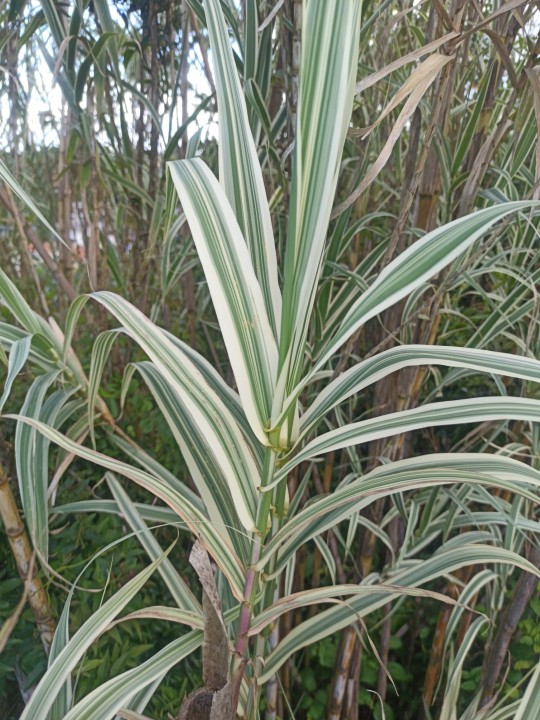

Arundo donax is a tall perennial cane. It is one of several so-called reed species. It has several common names including giant cane, elephant grass, carrizo, arundo, Spanish cane, Colorado river reed, wild cane, and giant reed. Arundo and donax are respectively the old Latin and Greek names for reed.
Ару́ндо тростнико́вый, или Тростни́к гига́нтский — вид цветковых растений рода Арундо семейства Злаки.
Арундо тростинний, арундо очеретяний — вид рослин родини тонконогові (Poaceae).
Clade:Monocots
Clade:Commelinids
Order:Poales
Family:Poaceae
Genus:Arundo
Arundo donax grows in damp soils, either fresh or moderately saline, and is native to the Greater Middle East. Arundo is a highly invasive plant in southwestern North American rivers, and its promotion as a biofuel in other regions is of great concern to environmental scientists and land managers. and in New Zealand it is listed under the National Pest Plant Accord as an "unwanted organism". In New Zealand's northernmost region, Arundo donax crowds out native plants, reduces wildlife habitat, contributes to higher fire frequency and intensity, and modifies river hydrology.
Ancient Egyptians wrapped their dead in the leaves. The canes contain silica, perhaps the reason for their durability, and have been used to make fishing rods.
This plant may have been used in combination with harmal (Peganum harmala) to create a brew similar to the South American ayahuasca, and may trace its roots to the Soma of lore.
Ancient Greeks used cane to make flutes, known as kalamaulos, from kalamos ("cane") + aulos ("flute"). A. donax is still the principal source material of reed makers for clarinets, saxophones, oboes, bassoons, bagpipes, and other woodwind instruments.
Интересно, что в норме он везде без белых полос, но видимо это эпигенетический признак вообще не влияющий на видовое определение. В iNaturalist подтвердили, что это описанный выше вид.
191-175 Browns Bay Road, Auckland 0630
7P9P+PM2 Auckland
-36.7307280, 174.7366280
наземные растения цветковые травы тростник злаковые
Common Names: bamboo reed; giant cane; spanish reed; wild cane. Spanish: caña común; caña de Castilla; carizo; carrizo. French: canne de Provence; grand roseau. Arabic: ghab; qalam. Chinese: lu zhu. Portuguese: cana palustre; canno de reino. Australia: bamboo; Danubian reed; e-grass; elephant grass; giant Danube grass; oboe reed. Brazil: cana do brejo; cana do reino; cana-brava; canno do reino; capim plumoso; taquara-do-reino. Chile: cañamo. Colombia: caña brava. Costa Rica: caña hueca. Cuba: caña de Castilla; caña de río; caña hueca; cañita de la india. Dominican Republic: cañita. Fiji: ngasau ni vavalangi. Germany: Pfahlrohr. Haiti: herbe roseau; roseau. India: nal. Italy: canna commune; canna comune; canna di Provenza. Netherlands: Pijlriet. Puerto Rico: caña gigante; guajana. Samoa: fiso palagi. South Africa: Spaanse-riet. Spain: falso bamboo; gallipato alcublano; junco gigante. Tonga: kaho; kaho folalahi. Uruguay: caña musical.
The root is diaphoretic, diuretic, emollient and galactofuge. An infusion is said to stimulate menstrual discharge and diminish milk flow. A paste of the root is applied to the forehead to treat headaches. Isolated alkaloids have been experimentally shown to raise the blood pressure and contract the intestine and uterus. The rhizome or rootstock is used in the treatment of dropsy. Boiled in wine with honey, the root or rhizome has been used for treating cancer. The plant contains the alkaloid gramine. This is said to be a vasopressor, raising the blood pressure in dogs after small doses, causing a fall in larger doses. The stems have been used as splints for broken limbs
В сельских регионах Испании на протяжении веков существовала техника строительства, носящая имя каньизо cañizo, использующая прямоугольники примерно 2 на 1 метр тканого тростника, к которому можно было добавлять глину или штукатурку. Крыша из правильно изолированного каньизо может сохранять свои механические свойства более 60 лет.
https://t.me/life_yura15cbx/1247?single&comment=4606


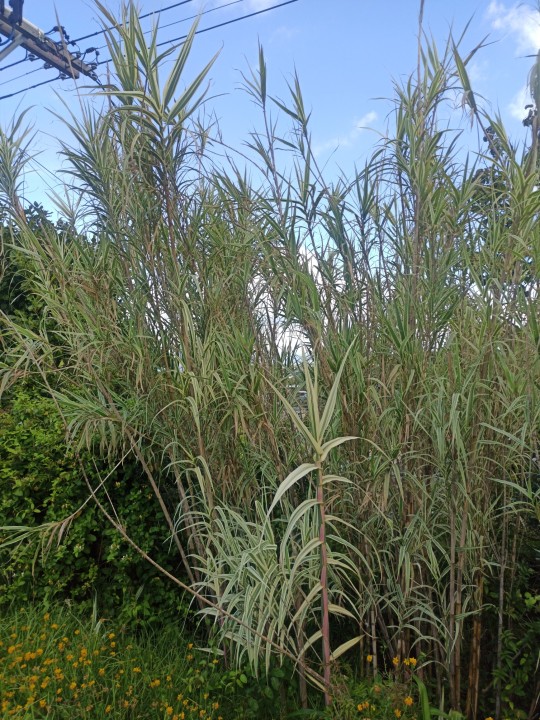
0 notes
Text
Evolution of Musical Instruments
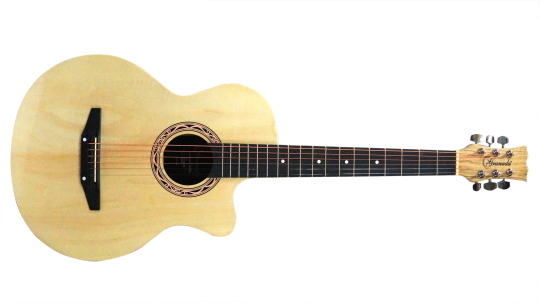
The evolution of musical instruments spans millennia, representing a fascinating journey through human creativity, technological advancements, cultural exchange, and artistic expression. From simple, ancient origins to the complex and diverse instruments of the modern era, this evolution reflects the rich tapestry of human ingenuity and cultural heritage.
The earliest known musical instruments date back tens of thousands of years. Archaeological findings reveal ancient flutes crafted from bird bones or mammoth ivory, percussion instruments made from hollowed-out objects like shells and logs, and various forms of early stringed instruments. These instruments, often associated with rituals, ceremonies, or communal gatherings, laid the foundation for musical expression in ancient societies.
Ancient civilizations across the globe contributed significantly to the development of musical instruments. The Egyptians created harps, lyres, and flutes, while the Greeks introduced the precursor to the modern guitar, known as the "kithara." Chinese dynasties brought forth the guqin and pipa, while Indian cultures developed instruments like the sitar and tabla, each with its unique construction and tonal qualities.
The Middle Ages witnessed an evolution in instrument design, with the emergence of more sophisticated keyboard instruments such as the organ, clavichord, and harpsichord. The Renaissance era further expanded the variety of instruments, including the violin family, brass instruments like trumpets and trombones, and the development of the modern flute and clarinet.
The Baroque and Classical periods witnessed refinements in instrument design, with instrument makers perfecting their craftsmanship. Innovations led to improvements in brass and woodwind instruments, such as the creation of the modern piano and advancements in violin-making techniques by famous luthiers like Antonio Stradivari.
The Industrial Revolution played a pivotal role in the evolution of musical instruments. Mass production techniques led to the standardization of instrument design and facilitated wider accessibility to instruments. Innovations in materials, such as the use of metal alloys in brass instruments and synthetic materials in strings and percussion, revolutionized instrument manufacturing and performance.
The 20th century marked a period of tremendous innovation and diversity in musical instruments. Advancements in technology gave rise to electronic instruments like synthesizers, electric guitars, and electronic keyboards, transforming the sound and possibilities of music production. These innovations enabled musicians to experiment with new sounds, genres, and musical styles.
The digital era further revolutionized music-making with the advent of digital synthesizers, MIDI (Musical Instrument Digital Interface) technology, and computer-based music production software. This allowed musicians to create, modify, and manipulate sounds in ways previously unimaginable, expanding the sonic landscape of music.
Today, the world of musical instruments continues to evolve rapidly. Instrument makers and innovators explore sustainable materials, incorporate cutting-edge technology, and blend traditional craftsmanship with modern design to create innovative and hybrid instruments. Instruments from various cultures are also being adapted and fused together, leading to the creation of entirely new sounds and genres.
In conclusion, the evolution of musical instruments reflects the diverse and intricate tapestry of human creativity, cultural heritage, technological advancements, and artistic expression. From the primitive origins of early instruments to the sophistication of modern electronic music production, this evolution embodies the constant pursuit of new sounds, musical innovation, and the universal language of music that transcends boundaries and connects people across time and cultures.
0 notes
Text
Star Covers Bios #9: Kelsey Conners
Age: 10 (beginning of series) 18 (current age)
Birthday: December 20 2004
Ethnicity: Asian (Mom: Japanese heritage Dad: Chinese Canadian heritage)
Born: St. John’s Newfoundland, Canada
Hair Colour: Black
Skin Tone: Pale White
Eye Colour: Brown
Colour Scheme: Fuchsia, Purple-Pink, Pale Pink, Black, Silver, Gold, White, and Lavender
Instruments: Drums, Vocals, Electronics, Piano, Turntables, Taiko (Japanese drums), and Shakuhachi (Japanese woodwind instrument)
Magical Element: Drums/Rhythms
Non-Topic Ability: Levitation
Weapon: Drumstick Whips
Hobbies: Playing drums, singing, recording, songwriting, skateboarding, rock climbing, collecting vinyls and cassettes, watching music documentaries, filming videos, and teaching drums
Good Qualities: She is a fierce and loyal person who’s always willing to help her family and friends even in the worst times. She’s very loving towards her friends, especially her girlfriend Maya whom she’s a smooth romantic to. She’s also the confident and cool member of the group
Bad Qualities: She gets angry. Like a lot. She’s has intense anger issues that makes her come off as terrifying. She’s also incredibly snarky which others makes her come off as passive aggressive when most of the time she’s only in a joking mood whenever she’s snarky. She tends to hold grudges easily
Inspirations: Kiss (specifically Peter Criss [same birthday lol]), Herman Li of DragonForce, Abba, Glam Metal stars, and Musa from Winx Club
#kiss band#hard rock#momoiro clover z#duran duran#the beatles#the monkees#writerscorner#character design#rock music
0 notes
Text

jing yuan's theme is bookended by... uhhh... guzheng? pipa? i'm very bad at instrument identification. whatever it is, it's the main instrument i associate with him but it only really features itself during the beginning and ending
meanwhile blade's... xiao? is it a xiao? blade's woodwind is present and carries a melody through the majority of his song, even when it's being outshone by that really loud mara instrumentation
blade and jing yuan share the exact same key until blade's mara overtakes him, at which point he raises by two semitones and never recovers to baseline. the implications... the shrimplications... i'm sick about their relationship...
the renjing key is e minor because they make me emo and blade's mara key is f sharp minor because his sword is really fucking sharp
at the start of the song, blade is very slightly slower than jing yuan, but as soon as the action starts they're both at the exact same tempo and stay that way until jing yuan floats off at the end
jing yuan starts and ends on the octave, but he starts at the highest note and ends at the lowest. 堂堂正正的 boy. does things by the book boy. at the end of the day he's sad though.
blade starts in the middle of the octave and ends on the same low note as jing yuan. or he would have if not for the mara... fuck me
the sound of war drums is like the indication from the commander for the soldiers to go ahead. jing yuan is the general of the luofu and his theme prominently features drums
blade and jing yuan have the same incoming battle leitmotif and they both share the same little trills marking every measure for blade and every few measures for jing yuan
at least until their point of divergence, which is also when both of their other signature instruments come in, which is when jing yuan summons the spirit lord and identifies himself with the xianzhou and when blade succumbs to mara and identifies himself against it
the mix of electronic and traditional chinese instrumentation is shared with the rest of the xianzhou music. and it is extremely sick.
okay your ship is cool but can it do THIS
33 notes
·
View notes
Text
When Art Becomes Industry - The Menu Review
For my elementary school yearbook, I was given a slip of paper that had me answer the following prompt: "What do you think you'll be when you grow up?" These would later be printed just below my name and portrait that would proudly beam on the glossy pages of the 5th grade section of the yearbook, among the other classmates off to do wonderful and ambitious things as preteens in middle school. In short, this was like a high school yearbook quote, but a little more hopeful and earnest.
I answered Probably a comic book writer or a piano player. While the use of "Probably" helped me ease into the idea of letting go of my short-lived comic book writing ambitions, it still amazes me today that, at 10 years old, I knew in my heart that the piano would be a part of my life.
My earliest memories come from the time when I was a toddler who could barely walk, stumbling down the soft carpeted hallway of my childhood home in South San Francisco as I approached the mysterious and booming mid-range tones from the piano in the living room. I'd see my dad's legs, rhythmically pressing on the ornate pedals with the balls of his feet at irregular intervals, like he was operating a weave as he conjured up a net of harmonies beneath his palms. While I might not have fully comprehended it at the time, there was a understanding in our family that the piano is a gene in our household, and I inherited it from my dad, whether I liked it or not.
Fortunately, I did like it. My dad took me to my first piano lesson when I was five years old, in the back of a Chinese-owned musical instrument shop on Clement Street. I never saw that teacher again (maybe the first lesson was complimentary, and my dad just didn't like her enough), but I got to keep the book. At home, with the help of 12 colorful cartoon characters printed in my book, I taught myself all 12 notes in the scale (more if you want to count the treble and bass clefs), simply because I was hungry to learn more notes and more songs. I took great pride when my dad clapped for me finishing Mary Had A Little Lamb, and shame when he reprimanded me for improvising wrong notes. I loved learning new songs, and held myself over with nursery rhymes and folk songs until it was time to take formal classical lessons from a teacher who met my dad's approval. At nine years old, I finally was reaching the next step.
My piano teacher introduced me to the world of music education and the rigors of music training. She was compassionate and warm, but demanded dedication. Through her, I internalized the technicalities of finger placements, metronome speeds, hand compartmentalization. I expanded my repertoire to included Russian contemporary composers whose surnames sounded like Harry Potter spells, but whom sometimes wrote the easiest pieces for my nimble fingers. I reckoned with the performance anxiety that dreaded my psyche before every monthly recital, which eventually bled over to my Certificate of Merit performance auditions. While I changed schools and subjects during the day, music became the constant test that loomed over me.
By the time I became an adolescent, I had nothing to show for it. In high school, it dawned on me that, not only was the piano barely used in any high school ensemble, but everyone knew how to play it better than I did. Everyone knew an ensemble-friendly instrument, whether it was a string instrument for the orchestra, a woodwind for the symphonic band, or a brass for both. All I had was piano, an instrument that's barely heard unless there's a solo, a concerto, or a jazz rhythm section involved. If I wanted to be heard, I had to be perfect. All 4 years of high school, I didn't pass a single audition for piano - not for the school jazz ensemble, not for any of the school musical pit orchestras. I dreaded each audition anyway, and probably flubbed them out of nervousness. I only got into orchestra after I begged the music director and offered to be a TA and a percussionist for the orchestra class, and the one time I did play in the musical pit orchestra was for percussion.
The stress and pressure I felt in the rigors of the music world left me jaded; they were a sobering reminder that I would never be cut for a career in music, or at least as a piano player, as my 10-year-old self prophetically proclaimed. My worth was at the whim of directors listening for every perfect note. The world was telling me that I wasted my time with the piano, a constant reminder of my own inadequacy. I became angry. I lost sight of why I was even spending time and money on these piano lessons, when I had schoolwork and college applications to worry about.
It's this jaded feeling that I think The Menu fully understands. Ralph Fiennes' Julian Slowik is a world-renowned chef who uses his reputation and art to seek retribution for the ills of the arts-turned-service industries. His dishes are the visceral expressions of his stoic hatred and rage for the pretentious, capitalist, and opportunistic subculture that has plagued his beloved art. Having been deeply engrossed in the higher world of fine dining, he manipulates and upends the culture to his own vengeful benefit, usurping expectation and surprising his guests (and by extension, us) by forcing them to confront their dismissive participation and moral crimes against art and humanity. In public reference does he create his own personal chaos, a heaven out of a living hell for those he finds undeserving.
There's a point in the film in which we see Slowik's origins. In one photo shown, he's younger, relaxed, and smiling, holding up a greasy burger patty on a flat and wide spatula, like the kind you'd see in cartoons. It's in stark contrast to the Slowik we got used to seeing, a stoic and terse statue of a man with thunderous claps and a commanding presence, arms crossed. And it's this point in the film where we see it's emotional core, an outlet for our own passionate angst and frustrations. We see a man who was once happy, doing what he loved, now grown into a bitter, spiteful shell.
With nothing else to audition for (save for the slightly less rigorous annual piano tests I habitually studied and trained for), my time with the piano became much for personal. Around my early adolescence, my love and ear for music bloomed with The Beatles, and the piano became the perfect outlet for that rediscovered joy and love of music. Like how I was when I was five, I began dedicating myself to learning more and more songs I loved, Beatles and beyond. I sought new territory and creativity in jazz piano and improvisation, a new language that was previously shunned from me.
When I see Ralph Fienne's Slowik as he is, I am reminded of all of those failed auditions, those nights slumped on the piano bench, those feelings of worthlessness, and if I sat through more of those and eventually found the success I was looking for, I'd come out a shell like him. But, when I see Slowik cooking a burger, I am thrust with nostalgia for the days when I learned Beatles songs on the piano, noodled jazz piano solos over wavy chords, and weaving harmonies out of thin air.
So yeah, I got pretty emotional watching this.
59 notes
·
View notes
Note
I want to start learning Violin! I have a background in Percussion (7 years) and woodwind instruments (4 years) but I have no idea where to start when it comes a good starter Violin. Do you have any recommendations for brands or examples of what I should look for?
exciting !! id definitely start out with a rental, but price and quality is pretty variable and dependent on where you are
i know a lot of people go through shar music for online rentals, and they also do rent to buy so you’d be renting with the intention of keeping it if you like it. potter violins seemed to be popular too, though that may have been a regional thing since i grew up in virginia. (these are both domestic us only i believe, unfortunately i don’t have any personal experience w online rentals outside of the us ://)
if you’re just looking to purchase outright, i’d honestly recommend getting an appointment at a local shop, letting them know your price range, and just trying things out. it’s a little more difficult if you don’t have things like scales and a piece or two in your back pocket yet to compare sound quality, but it’s really important to pick an instrument based on the sound and how it feels in hand. when you’re looking to purchase, most shops will let you take instruments out on trial for some time, so take advantage of that if you can.
bows are super important to how an instrument sounds too, so when testing different instruments, try to keep the bow a constant. i know it’s a little tacky to talk dollar amounts, but i would say if a nice student violin usually starts at around 2k, a nice bow is likely going to start at about 500? these are by no means hard figures, and the most important thing about playing is the sound. i would definitely ask to try out at least a few different bows, if ur able
also, don’t shy away from contemporary american instruments and chinese instruments ! you’ll have a lot of people trying to push you towards german and italian violins, but they’re not necessarily better and likely are a lot more expensive than the quality would dictate. older and european doesn’t necessarily mean better !!!!!!! chinese factory instruments get a bad rep but honestly? they’re not all terrible and can actually be really cost effective, especially if you’re just getting started and dont plan on sinking a ton of time/effort/money into a violin. but if they don’t let you take it out on trial, please, please do not purchase !!!!!!!!!
last bit: i know i said sound is the most important but let’s be honest, the aesthetics do kinda matter lolol.. you don’t like the shape/placement/height of the chin rest? easily changed. you’d like more decorative pegs? easily changed. the tail piece is ugly? easily changed. i love my viola, its served me well and is perfect for the type of playing i do, but man… the second i get a chance, im stripping the varnish and changing the color because i cannot stand how red it is. idk that i have a point with this part besides if you hate the varnish now, you’ll likely still hate it in 10 years
sorry for the info dump, i know a lot of it is probably a bit premature for where u are in the renting/purchasing process, but i hope it’s a least a little helpful ! if u want more specific advice later on strings/setup/rosin/case stuff or even just a second opinion on pricing, i’d be happy to help <33333
28 notes
·
View notes
Video
youtube
This reminds me of that movie where the Western orchestra and Chinese music students had a music battle, and the moment the suona comes out the Western music department gets confused LOL.
I guess the whole point of it is that you just can not make the sound suona makes with any Western instrument? I dunno, I’m curious TBH. Is it really not doable (even with trumpets or the piccolo)? Like, the suona does have this “nasal” sound to it compared to woodwind instruments or the brass instruments, but if we disregard that “unique sound” and just talk terms of the pitch and range...?
5 notes
·
View notes
Text
symphony orchestra
I chose the theme of the symphony orchestra.
In my childhood, I also learned the piano, but unfortunately I did not stick to it due to academic reasons, or maybe I did not like it enough. But the music is always in my mind. After many years, I was lucky enough to hear the Berlin Philharmonic perform live, and it was truly amazing. Here I suggest that everyone should go to a live orchestra if they have the chance. The sounds of different instruments are interwoven to form a harmonious score that is beyond words.
A symphony orchestra is a large orchestra. The symphony orchestra was finalized in the 1820s and became popular in Europe and the world. A symphony orchestra generally includes five instrumental groups, namely string group, woodwind group, brass group, percussion group and color instrument group.
The string group is a family of violins, including the first violin, the second violin, viola, cello, and double bass; the woodwind group includes piccolo, flute, oboe, clarinet, British pipe, big pipe, etc.; the brass group includes horns, small pipes, etc. Horn, trombone, tuba, etc.; percussion group includes timpani, snare drum, bass drum, triangle, cymbal, gong, etc.; color instrument group includes piano, harp, row clock, organ, etc.
The origin of symphonic music can be traced back to a very distant historical process. Its name comes from ancient Greece, where the word "symphony" is a combination of the words "harmony" and "harmony." The original use of symphonies is also confusing. The etymologically original Greek symphony simply meant "together" (syn) "to make a sound" (phone), but in the Middle Ages it referred to the harmonious union of two sounds, including an early vocal or instrumental composition, or the harmonious union of several sounds on certain instruments such as bagpipes and accordions. At the end of the sixteenth century, any musical passage inserted in a dramatic work (including opera and diva) that was not in concert was called a symphony.
The meaning of the Renaissance period and now is completely different, then the symphony generally refers to all the multi-voice music, including vocal and instrumental music. The name symphony has been taken as the symbol of all harmonic, multimusical music. This is on the basis of the medieval "art nouveau", more pursuit of the liberation of human nature and the inner feelings of the people's calligraphy and expression.
At the beginning of the eighteenth century, music art developed rapidly in Europe. With the process of industrial revolution in Europe, music art also began to be gradually popularized and socialized. During this period, the scale and form of the symphony as an independent art form gradually took on a clear meaning: overtures and interludes began to break away from opera and to be played separately in concerts. This played an important role in the development of the symphony.
The modern symphony orchestra, with its five instrumental groups, was also formed at that time.
Later in the twentieth century, the development of the band was divided into two tendencies: one was to continue to expand the organization of the band, and the other was to revert to the eighteenth-century chamber music style of the band.

Image 1: The concert of the Berlin Philharmonic Orchestra

Image 2: The photo I took from the concert
In the course of development, China's symphony orchestra combined the unique Chinese Musical Instruments and added them to the music, bringing very different changes, such as zheng, guqin, xiao, pipa and other Musical Instruments.
In fact, I chose symphony orchestras as my theme not only because I'm interested in symphony orchestras, but also because my favorite games have collaborated with symphony orchestras to great effect.
So I thought we could try to combine the symphony orchestra with costume design. Maybe there would be some interesting sparks. Music may not seem to be a necessity of human life, but there is no lack of it in people's spiritual world.
I wish I could show this in the back, just like I did when I was at the concert.
https://www.bilibili.com/video/BV1eA411v78z
https://www.bilibili.com/video/BV1xp4y16761
(two links about the music in the games)
1 note
·
View note